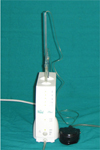1. Locker D, Sharpiro D, Lidell A. Who is dentally anxious? Concordance between measures of dental anxiety. Community Dent Oral Epidemiol. 1996; 24:346–350.

2. Meechan JG, Howlett PC, Smith BD. Factors influencing the discomfort of intraoral needle penetration. Anesth Prog. 2005; 52:91–94.

3. Friedman MJ, Hochman MN. A 21st century computerized injection system for local pain control. Compend Contin Educ Dent. 1997; 18:995–1003.
4. Palm AM, Kirkegaard U, Poulsen S. The wand versus traditional injection for mandibular nerve block in children and adolescents: Perceived pain and time of onset. Pediatr Dent. 2004; 26:481–484.
5. Kandiah P, Tahmassebi JF. Comparing the onset of maxillary infiltration local anaesthesia and pain experience using the conventional technique vs. the Wand in children. Br Dent J. 2012; 213:E15.

6. Krochak M, Friedman N. Using a precision metered injection system to minimize dental injection anxiety. Compend Contin Educ Dent. 1998; 19:137–148.
7. Katz J, Melzack R. Measurement of pain. Surg Clin North Am. 1999; 79:231–252.

8. Malamed SF. Handbook of local anesthesia. 4th ed. St. Louis: Mosby;1997. p. 191–218.
9. Goodell GG, Gallagher FJ, Nicoll BK. Comparison of a controlled injection pressure system with a conventional technique. Oral Surg Oral Med Oral Pathol Oral Radiol Endod. 2000; 90:88–94.

10. Tahmassebi JF, Nikolaou M, Duggal MS. A comparison of pain and anxiety associated with the administration of maxillary local analgesia with Wand and conventional technique. Eur Arch Paediatr Dent. 2009; 10:77–82.

11. Yenisey M. Comparison of the pain levels of computercontrolled and conventional anesthesia techniques in prosthodontic treatment. J Appl Oral Sci. 2009; 17:414–420.

12. Yesilyurt C, Bulut G, Taşdemir T. Pain perception during inferior alveolar injection administered with the Wand or conventional syringe. Br Dent J. 2008; 205:E10.

13. Nusstein J, Lee S, Reader A, Beck M, Weaver J. Anesthetic efficacy of the anterior middle superior alveolar injection. Anesth Prog. 2004; 51:80–89.
14. Asarch T, Allen K, Petersen B, Beiraghi S. Efficacy of a computerized local anesthesia device in pediatric dentistry. Pediatr Dent. 1999; 21:421–424.
15. Gibson RS, Allen K, Hutfless S, Beiraghi S. The Wand vs. traditional injection: a comparison of pain related behaviors. Pediatr Dent. 2000; 22:458–462.
16. Allen KD, Kotil D, Larzelere RE, Hutfless S, Beiraghi S. Comparison of a computerized anesthesia device with a traditional syringe in preschool children. Pediatr Dent. 2002; 24:315–320.
17. Fukayama H, Yoshikawa F, Kohase H, Umino M, Suzuki N. Efficacy of anterior and middle superior alveolar (AMSA) anesthesia using a new injection system: the Wand. Quintessence Int. 2003; 34:537–541.
18. Palm AM, Kirkegaard U, Poulsen S. The wand versus traditional injection for mandibular nerve block in children and adolescents; perceived pain and time of onset. Pediatr Dent. 2004; 26:481–484.
19. Nicholson JW, Berry TG, Summitt JB, Yuan CH, Witten TM. Pain perception and utility: a comparison of the syringe and computerized local injection techniques. Gen Dent. 2001; 49:167–173.
20. Hochman M, Chiarello D, Hochman CB, Lopatkin R, Pergola S. Computerized local anesthetic delivery vs. traditional syringe technique: subjective pain response. N Y State Dent J. 1997; 63:24–29.
21. Loomer PM, Perry DA. Computer-controlled delivery versus syringe delivery of local anesthetic injections for theurapeutic scaling and root planing. J Am Dent Assoc. 2004; 135:358–365.

22. Price DD, Bush FM, Long S, Harkins SW. A comparison of pain measurement characteristics of mechanical visual analogue and simple numerical rating scales. Pain. 1994; 56:217–226.









 PDF
PDF ePub
ePub Citation
Citation Print
Print






 XML Download
XML Download